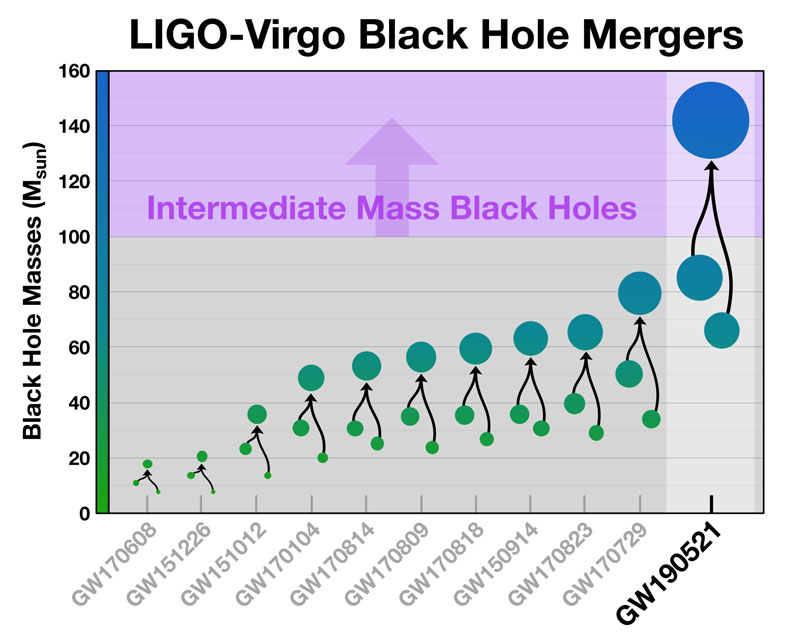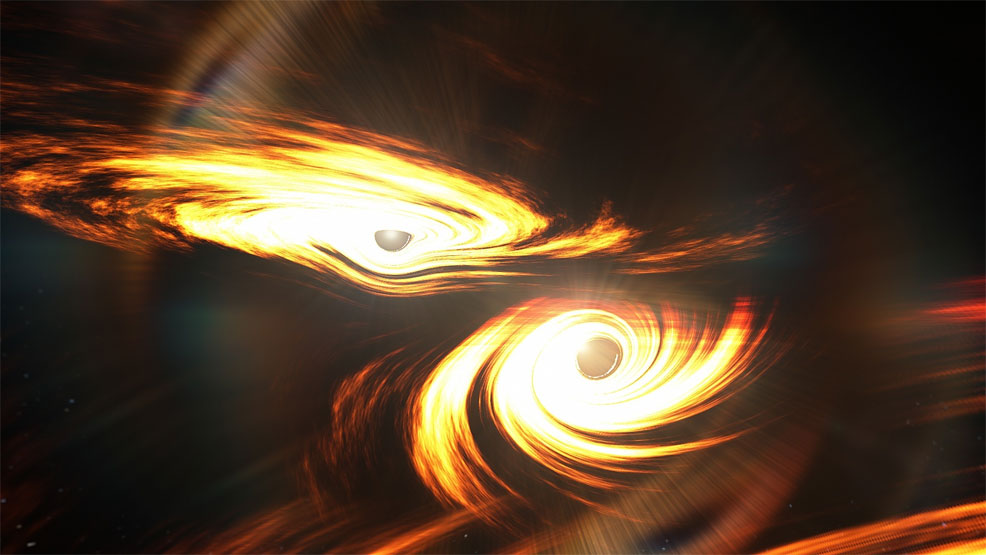
5th September 2020 Largest known black hole merger is confirmed Astronomers at the LIGO and Virgo detectors have confirmed the largest known black hole merger, which also provides the first clear evidence of an intermediate-mass black hole. The resulting object, producing a gravitational wave called GW190521, is estimated at 142 solar masses.
Black holes are formed by the collapse of very massive stars at the end of their life cycle. A typical stellar-mass black hole ranges from about five to several tens of solar masses. In other words, it has a mass at least five times that of our Sun, with an upper limit usually defined as approximately one hundred. For some additional perspective, the Sun accounts for 99.8% of the mass in our entire Solar System. At the centre of most large galaxies are supermassive black holes. These monstrous, swirling regions can be formed by absorbing many smaller black holes. Sagittarius A*, which lies at the core of our own galaxy, is estimated at 4.1 million solar masses, but the very largest supermassive black holes in the universe can reach tens of billions of solar masses, with event horizons equivalent in radius to the orbit of Uranus. There is, however, a third class: intermediate-mass black holes, which exceed the 100 solar masses of typical stellar mass black holes, but lie below the 100,000 lower limit of the supermassive monsters. These are elusive, and their origins less clearly understood. Only a handful of candidate objects have been identified in our galaxy and others nearby, determined only by indirect gas cloud velocity and accretion disk spectra observations. The Laser Interferometer Gravitational-Wave Observatory (LIGO) in the United States, with help from the Virgo Collaboration in Europe, has now obtained the first definitive evidence of an intermediate-mass black hole. Two stellar-mass black holes – 85 and 66 solar masses, respectively – combined to form a new object with 142 solar masses, exceeding the 100 threshold. The nine remaining solar masses (since 85 plus 66 does not equal 142) radiated outward in the form of gravitational waves, categorised as GW190521.
The sheer magnitude of forces involved in this collision is almost beyond comprehension. In just a fraction of a second, two objects with a combined mass equivalent to 151 of our Solar Systems moved together to create a single massive object. This literally caused ripples in the fabric of space-time. LIGO detected this merger and the enormous amount of energy it produced in May 2019. This week, scientists officially confirmed that, based on analysis of the gravitational wave data, GW190521 is the result of an intermediate-mass black hole being formed. The signal, resembling four short wiggles, lasted for barely one-tenth of a second. This brief but extremely powerful event – the largest of its kind ever recorded – took place more than 17 billion light years away. This means it occurred at a time when the universe was only half its current age, which also makes it one of the most distant gravitational-wave sources detected so far. "This doesn't look much like a chirp, which is what we typically detect," said Virgo member Nelson Christensen, a researcher at the French National Centre for Scientific Research (CNRS). "This is more like something that goes 'bang,' and it's the most massive signal LIGO and Virgo have seen." The astronomers from LIGO and Virgo have reported their findings in two new papers. One, appearing in Physical Review Letters, details the discovery; the other, in Astrophysical Journal Letters, discusses the signal's physical properties and astrophysical implications. LIGO has been operational since 2002, with an upgrade completed in 2015. The facility made headlines in early 2016 when a team of scientists announced the first detection of gravitational waves. They can now add the first definitive evidence of an intermediate-mass black hole to their list of achievements. LIGO is based at two separate locations on opposite sides of the United States, but future observatories could work better in space, without the need to maintain an artificial vacuum in the laboratory, and a complete lack of interference from seismic noise or human activities. The Laser Interferometer Space Antenna (LISA) is planned for launch in 2034, consisting of three spacecraft forming a triangle that spans 2.5 million km (1.6 million miles). It will track relative displacements with a resolution of 20 picometres – 1/50 billionth of a metre – less than the width of a helium atom. Ripples in space-time with periods ranging from a few minutes to a few hours could be detected by LISA, and several thousand objects are expected to be resolved within the first year of operation. A better understanding of gravitational waves could lead to new insights regarding the early Universe and its expansion, as well as improving our models of galactic evolution. Perhaps in the distant future, it could lead to new technology, too – just like better understanding radio waves, microwaves and X-rays led to various new inventions. Maybe our descendants will generate artificial gravitational waves, for example, and find ways to manipulate the fabric of space-time.
--- Follow us: Twitter | Facebook | Instagram | YouTube
Comments »
If you enjoyed this article, please consider sharing it:
|








